Quiz

The output of the trace route from R5 shows a loop in the network. Which configuration
prevents this loop?
A)
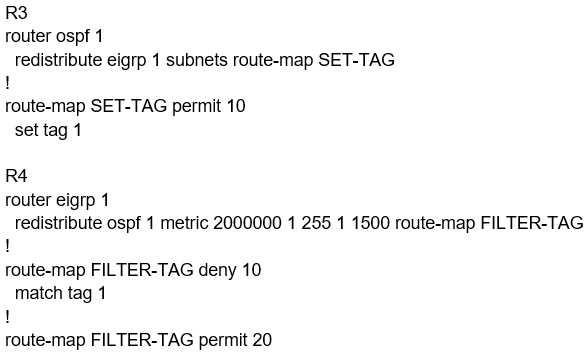
B)

C)
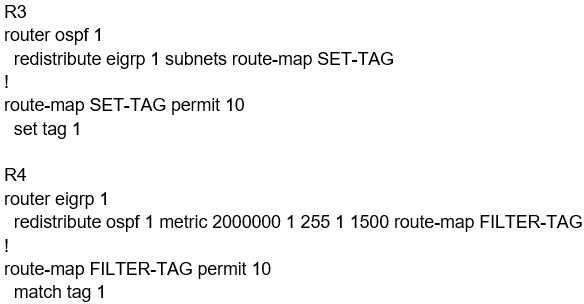
D)
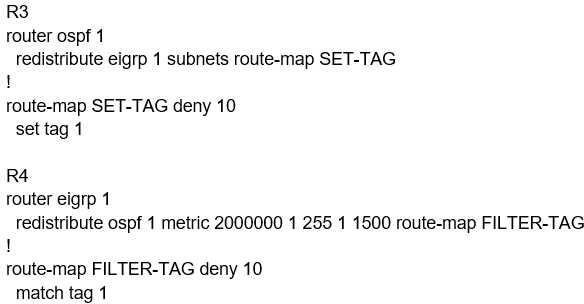
Quiz
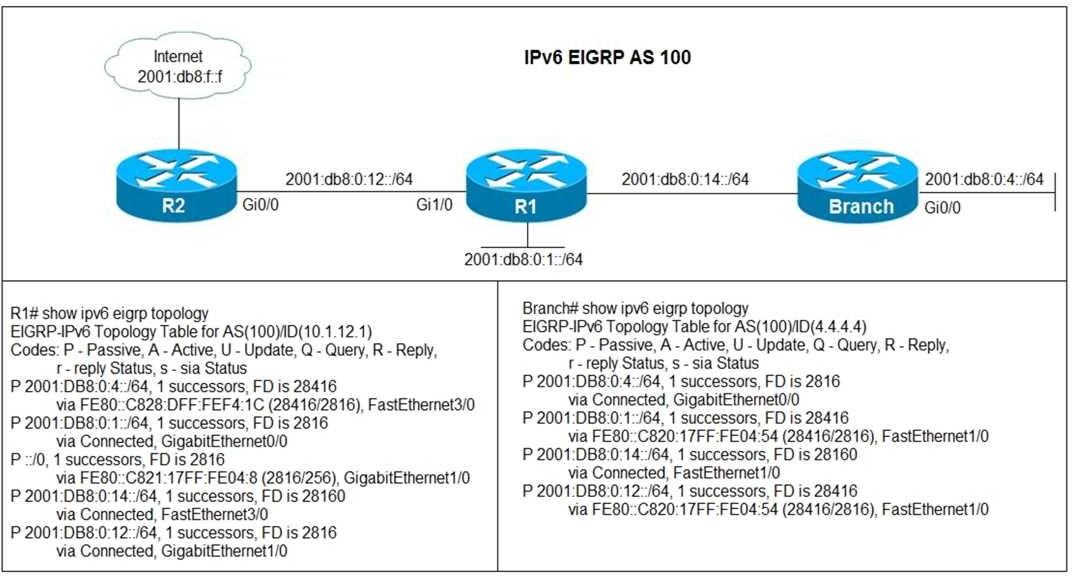
Users in the branch network of 2001:db8:0:4::/64 report that they cannot access the Internet. Which
command is issued in IPv6 router EIGRP 100 configuration mode to solve this issue?
Quiz

Which configuration configures a policy on R1 to forward any traffic that is sourced from
the 192.168.130.0/24 network to R2?
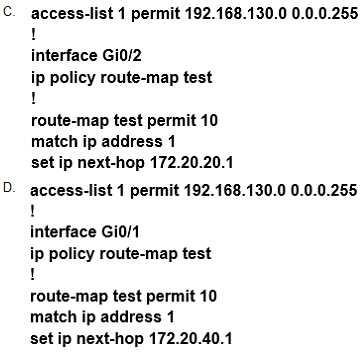
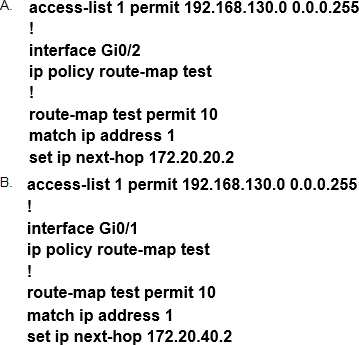
Quiz

What is the result when the route-map OUT command is applied toward an eBGP neighbor R1
(1.1.1.1) by using the neighbor 1.1.1.1 route-map OUT out command?
Quiz
routing table or influencing the IP data plane?
Quiz
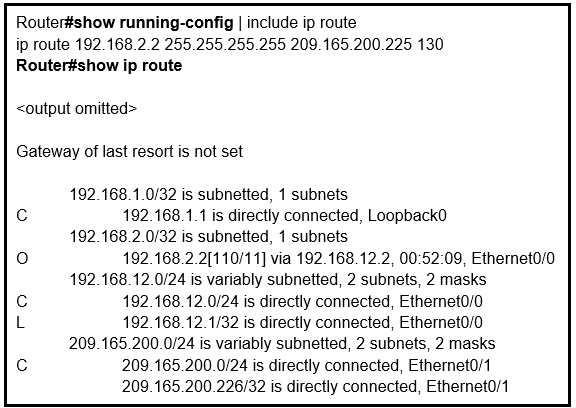
An engineer configures a static route on a router, but when the engineer checks the route
to the destination, a different next hop is chosen. What is the reason for this?
Quiz
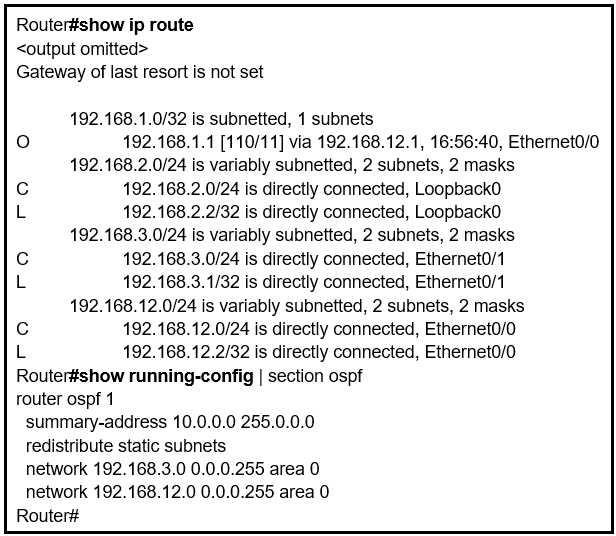
An engineer is trying to generate a summary route in OSPF for network 10.0.0.0/8, but the
summary route does not show up in the routing table. Why is the summary route missing?
area.
Quiz
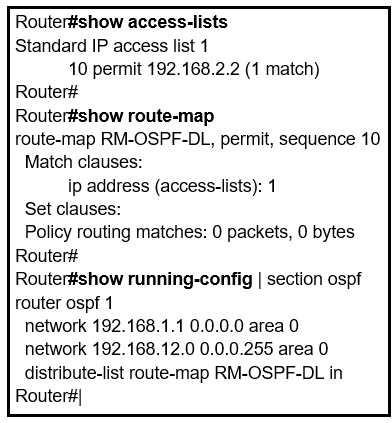
An engineer is trying to block the route to 192.168.2.2 from the routing table by using the
configuration that is shown. The route is still present in the routing table as an OSPF route. Which
action blocks the route?
Quiz
Quiz
Drag and drop the OSPF adjacency states from the left onto the correct descriptions on the right.
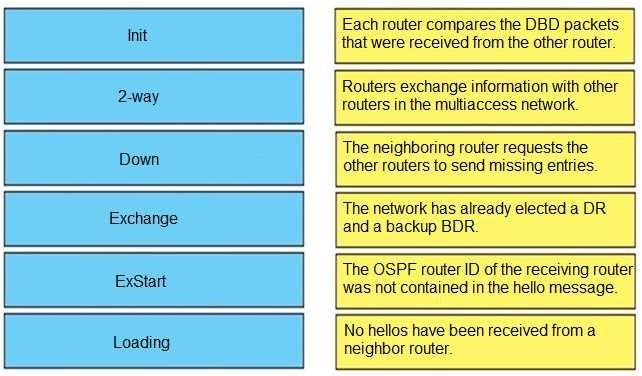
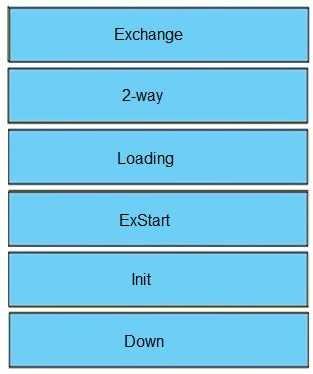
(Reference: http://www.cisco.com/en/US/tech/tk365/technologies_tech_note09186a0080093f0e.sh
tml)
Reference: https://www.cisco.com/c/en/us/support/docs/ip/open-shortest-path-first-ospf/13685-
13.html
Down
This is the first OSPF neighbor state. It means that no information (hellos) has been received from
this neighbor, but hello packets can still be sent to the neighbor in this state.
During the fully adjacent neighbor state, if a router doesn't receive hello packet from a neighbor
within the Router Dead Interval time (RouterDeadInterval = 4*HelloInterval by default) or if the
manually configured neighbor is being removed from the configuration, then the neighbor state
changes from Full to Down.
Attempt
This state is only valid for manually configured neighbors in an NBMA environment. In Attempt state,
the router sends unicast hello packets every poll interval to the neighbor, from which hellos have not
been received within the dead interval.
Init
This state specifies that the router has received a hello packet from its neighbor, but the receiving
router's ID was not included in the hello packet. When a router receives a hello packet from a
neighbor, it should list the sender's router ID in its hello packet as an acknowledgment that it
received a valid hello packet.
2-Way
This state designates that bi-directional communication has been established between two routers.
Bi-directional means that each router has seen the other's hello packet. This state is attained when
the router receiving the hello packet sees its own Router ID within the received hello packet's
neighbor field. At this state, a router decides whether to become adjacent with this neighbor. On
broadcast media and non-broadcast multiaccess networks, a router becomes full only with the
designated router (DR) and the backup designated router (BDR); it stays in the 2-way state with all
other neighbors. On Point-to-point and Point-to-multipoint networks, a router becomes full with all
connected routers.
At the end of this stage, the DR and BDR for broadcast and non-broadcast multiaccess networks are
elected. For more information on the DR election process, refer to DR Election.
Note: Receiving a Database Descriptor (DBD) packet from a neighbor in the init state will also a cause
a transition to 2-way state.
Exstart
Once the DR and BDR are elected, the actual process of exchanging link state information can start
between the routers and their DR and BDR. (ie. Shared or NBMA networks).
In this state, the routers and their DR and BDR establish a master-slave relationship and choose the
initial sequence number for adjacency formation. The router with the higher router ID becomes the
master and starts the exchange, and as such, is the only router that can increment the sequence
number. Note that one would logically conclude that the DR/BDR with the highest router ID will
become the master during this process of master-slave relation. Remember that the DR/BDR election
might be purely by virtue of a higher priority configured on the router instead of highest router ID.
Thus, it is possible that a DR plays the role of slave. And also note that master/slave election is on a
per-neighbor basis.
Exchange
In the exchange state, OSPF routers exchange database descriptor (DBD) packets. Database
descriptors contain link-state advertisement (LSA) headers only and describe the contents of the
entire link-state database. Each DBD packet has a sequence number which can be incremented only
by master which is explicitly acknowledged by slave. Routers also send link-state request packets and
link-state update packets (which contain the entire LSA) in this state. The contents of the DBD
received are compared to the information contained in the routers link-state database to check if
new or more current link-state information is available with the neighbor.
Loading
In this state, the actual exchange of link state information occurs. Based on the information provided
by the DBDs, routers send link-state request packets. The neighbor then provides the requested link-
state information in link-state update packets. During the adjacency, if a router receives an outdated
or missing LSA, it requests that LSA by sending a link-state request packet. All link-state update
packets are acknowledged.
Full
In this state, routers are fully adjacent with each other. All the router and network LSAs are
exchanged and the routers' databases are fully synchronized.
Full is the normal state for an OSPF router. If a router is stuck in another state, it is an indication that
there are problems in forming adjacencies. The only exception to this is the 2-way state, which is
normal in a broadcast network. Routers achieve the FULL state with their DR and BDR in
NBMA/broadcast media and FULL state with every neighbor in the remaining media such as point-to-
point and point-to-multipoint.
Note: The DR and BDR that achieve FULL state with every router on the segment will display
FULL/DROTHER when you enter the show ip ospf neighbor command on either a DR or BDR. This
simply means that the neighbor is not a DR or BDR, but since the router on which the command was
entered is either a DR or BDR, this shows the neighbor as FULL/DROTHER.
Reference: https://www.cisco.com/c/en/us/support/docs/ip/open-shortest-path-first-ospf/13685-
13.html
Reference: http://www.cisco.com/en/US/tech/tk365/technologies_tech_note09186a0080093f0e.sht
ml)
Reference: https://www.cisco.com/c/en/us/support/docs/ip/open-shortest-path-first-ospf/13685-
13.html
TESTLET-1.
Exam Pool A
Cisco Implementing Cisco Enterprise Advanced Routing and Services Practice test unlocks all online simulator questions
Thank you for choosing the free version of the Cisco Implementing Cisco Enterprise Advanced Routing and Services practice test! Further deepen your knowledge on Cisco Simulator; by unlocking the full version of our Cisco Implementing Cisco Enterprise Advanced Routing and Services Simulator you will be able to take tests with over 526 constantly updated questions and easily pass your exam. 98% of people pass the exam in the first attempt after preparing with our 526 questions.
BUY NOWWhat to expect from our Cisco Implementing Cisco Enterprise Advanced Routing and Services practice tests and how to prepare for any exam?
The Cisco Implementing Cisco Enterprise Advanced Routing and Services Simulator Practice Tests are part of the Cisco Database and are the best way to prepare for any Cisco Implementing Cisco Enterprise Advanced Routing and Services exam. The Cisco Implementing Cisco Enterprise Advanced Routing and Services practice tests consist of 526 questions and are written by experts to help you and prepare you to pass the exam on the first attempt. The Cisco Implementing Cisco Enterprise Advanced Routing and Services database includes questions from previous and other exams, which means you will be able to practice simulating past and future questions. Preparation with Cisco Implementing Cisco Enterprise Advanced Routing and Services Simulator will also give you an idea of the time it will take to complete each section of the Cisco Implementing Cisco Enterprise Advanced Routing and Services practice test . It is important to note that the Cisco Implementing Cisco Enterprise Advanced Routing and Services Simulator does not replace the classic Cisco Implementing Cisco Enterprise Advanced Routing and Services study guides; however, the Simulator provides valuable insights into what to expect and how much work needs to be done to prepare for the Cisco Implementing Cisco Enterprise Advanced Routing and Services exam.
BUY NOWCisco Implementing Cisco Enterprise Advanced Routing and Services Practice test therefore represents an excellent tool to prepare for the actual exam together with our Cisco practice test . Our Cisco Implementing Cisco Enterprise Advanced Routing and Services Simulator will help you assess your level of preparation and understand your strengths and weaknesses. Below you can read all the quizzes you will find in our Cisco Implementing Cisco Enterprise Advanced Routing and Services Simulator and how our unique Cisco Implementing Cisco Enterprise Advanced Routing and Services Database made up of real questions:
Info quiz:
- Quiz name:Cisco Implementing Cisco Enterprise Advanced Routing and Services
- Total number of questions:526
- Number of questions for the test:50
- Pass score:80%
You can prepare for the Cisco Implementing Cisco Enterprise Advanced Routing and Services exams with our mobile app. It is very easy to use and even works offline in case of network failure, with all the functions you need to study and practice with our Cisco Implementing Cisco Enterprise Advanced Routing and Services Simulator.
Use our Mobile App, available for both Android and iOS devices, with our Cisco Implementing Cisco Enterprise Advanced Routing and Services Simulator . You can use it anywhere and always remember that our mobile app is free and available on all stores.
Our Mobile App contains all Cisco Implementing Cisco Enterprise Advanced Routing and Services practice tests which consist of 526 questions and also provide study material to pass the final Cisco Implementing Cisco Enterprise Advanced Routing and Services exam with guaranteed success. Our Cisco Implementing Cisco Enterprise Advanced Routing and Services database contain hundreds of questions and Cisco Tests related to Cisco Implementing Cisco Enterprise Advanced Routing and Services Exam. This way you can practice anywhere you want, even offline without the internet.
BUY NOW